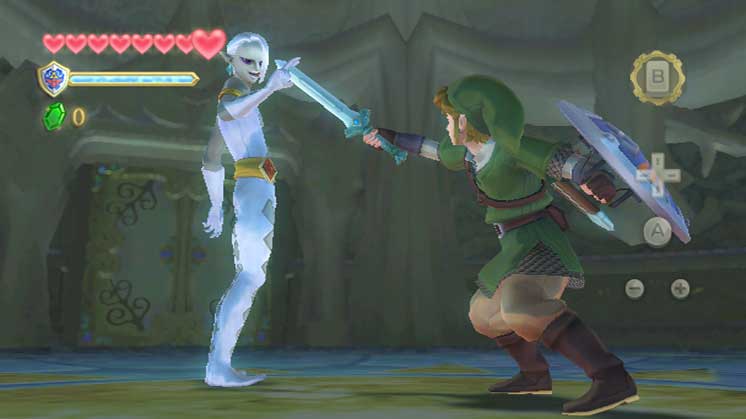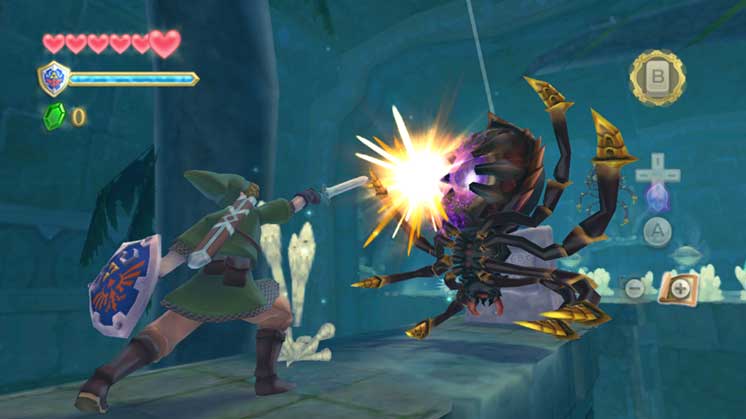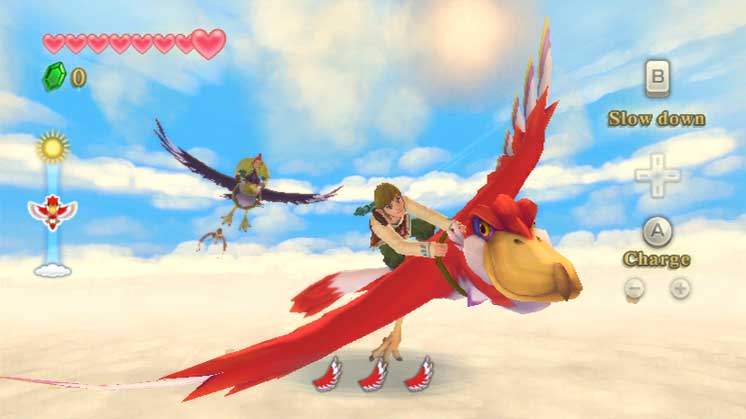Search
[{{{type}}}] {{{reason}}}
{{/data.error.root_cause}}{{{_source.title}}} {{#_source.showPrice}} {{{_source.displayPrice}}} {{/_source.showPrice}}
{{#_source.showLink}} {{/_source.showLink}} {{#_source.showDate}}{{{_source.displayDate}}}
{{/_source.showDate}}{{{_source.description}}}
{{#_source.additionalInfo}}{{#_source.additionalFields}} {{#title}} {{{label}}}: {{{title}}} {{/title}} {{/_source.additionalFields}}
{{/_source.additionalInfo}}Legend of Zelda: Skyward Sword (Wii)

Legend of Zelda: Skyward Sword
Developed by:Nintendo
Published by:Nintendo
Release Date:November 18, 2011
ESRB Rating: E10
Available on: Wii
Retail Price: $69.99 (with collector’s Wii Motion Plus Remote and CD), standard price without controller, $49.99
There I was, sitting in my den, watching in awe as Link moved his sword around in the exact same way that I was moving my Wii Remote around. True 1:1 swordplay. When I first experienced 1:1 swordplay in Wii Sports Resort, I hoped that Nintendo would make this fan’s dream come true and put those controls into a Zelda game. Let me just say, that I have been to Skyloft and I have saved the world with my blade firmly clenched in my hand.
The Legend of Zelda: Skyward Sword is the ultimate adventure experience on the Wii. Nintendo has asked us to fill the shoes of Link once again and dispatch the forces of evil for the sake of the world’s future. This is the core of every Zelda game and is what the fans have come to expect. So why can I say that I enjoyed it here more than ever before? How is it that a premise so predictable can be so enjoyable? As they say, it’s in the details.
Right from the beginning, you quickly realize that the design team made it their mission to improve e v e r y aspect of the Zelda experience. The look, the sound, the interface, the items, the enemies, the bosses, the dungeons, the NPC (non playable character) interaction, the pacing, the sidequests, the main quest, the extras and, of course, the controls have all been upgraded and improved from previous iterations. While this is truly a marvel in game design, there are some frustrating technical and moral issues that keep this gem from pure gaming perfection. The good news is the issues are but a mere fraction compared to the enormously enjoyable experience to be found here.
Sometimes I wonder what beautiful worlds the programmers at Nintendo could create with the PS3 or Xbox 360 hardware. For all that is said about the Wii not being able to compete graphically with the other two consoles, Skyward Sword shows the Wii can hold its own. Over is the feud between those who loved the toon shading of Wind Waker and the realistic world of Twilight Princess, as these two graphical styles are brought together unveiling a world that resembles a watercolour painting. There is a nice mixture between the bleak and the beautiful as some of the background vistas truly belong on a canvas. There are some environments that will simply take you by surprise.

Strong Points: A milestone in motion-gaming and creative game design.
Weak Points: Wii Motion Plus controller can lose calibration, high difficulty at times
Moral Warnings: Promotes Reincarnation, gameplay mainly revolves around killing.
The animation is equally great. Link moves as you would expect, but the enemies and characters living in Skyloft are fantastic. One shopkeeper really stands out – when you face him, he is overflowing with excitement; the moment Link turns his back, the man hilariously slumps in depression. The most notable, and laughable, problem with the game’s animations are the characters moving their mouths during songs or speech bubbles (rectangles?). 99% of the dialogue is reading text – yet most of the characters move their jaws as if they are actually speaking. Without spoiling much, your companion for the quest takes the cake for looking the most ridiculous at times. The bosses are very well animated and some of these monstrosities look absolutely amazing. And in my whole 52 hours of playing, only once did I experience a reduced framerate while playing, and it didn’t affect the gameplay at all.
The look of the game is complimented by the design of the dungeons. The world is broken into four basic areas – the floating village of Skyloft, the sky itself serving as the overworld hub, the areas below the clouds and the dungeons found within each. The genius here lies in each area that Link can explore. Previous Zelda games had put much effort in making each dungeon a puzzle and a place full of evil creatures, traps, and a challenging boss character. While this tradition continues here, each world is designed very much like a dungeon, as well. Exploration is rewarded with little insects to catch and rare treasures that you can find and collect. And there are a few gameplay twists that force you to approach each area a little differently every time you come back to them. My gaming chops were challenged, but this also ramps up the difficulty of the game at the same time.
The music and sound of Skyward Sword is incredible. Amidst some recognizable Legend of Zelda tunes, the themes of each area are unique, yet suitable to their location. And most characters have some sort of audible sound they make when you initiate a conversation. Most of Link’s yells and grunts carry over from the previous games, but hearing him get electrocuted never gets old. Link is also given an instrument to play (like previous Zelda games), and while you can have a bit of enjoyment playing as you wish, for the purposes of the game, its use is a little weak – it’s no ocarina. I should also note that the pleasant musical score playing in the background is replaced with simple and eerie silence at nighttime. A nice added touch.

Higher is better
(10/10 is perfect)
Game Score - 88%
Gameplay - 17/20
Graphics - 9/10
Sound - 10/10
Stability - 4/5
Controls 4/5
Morality Score - 87%
Violence - 6.5/10
Language - 10/10
Sexual Content - 10/10
Occult/Supernatural - 7/10
Cultural/Moral/Ethical - 10/10
Aside from your musical instrument, Link is given many other tools and weapons along the way. Most are series staples like the bow and arrow, slingshot and bombs. Others are new and surprisingly unique and useful. Some are more useful than others, but all of them get their fair amount of use. Accessing each one is as easy as holding the B button (pulling up the item ring) and pointing in the item’s direction to select it. Shigeru Miyamoto, the game’s creator, said he designed this to be like reaching into different pockets on your/ Link’s body. It works well as long as you are not sitting too slouched into your seat – trying to select one of the items lower in the ring can be hard if you are. They have included a secondary ring for items like your bottles (for fairies or potions), “ammo” pouches (arrows/ deku nuts/ bombs) and medals. Medals are a nice way to change different game elements like potion strength or how often rupees or hearts are found. This secondary ring is also limited, forcing you to choose what items to bring with you (the remaining items are kept at the Item Check). Some may note that the famous boomerang does not appear in this Zelda game – you’ll be glad to discover that it has been replaced with a handy little gadget called the Beetle. Again, the minds behind this game weren’t satisfied with simply having new items and a new item interface, but each item can be upgraded! The Beetle at its most advanced level is quite a handy little contraption.
The key item in the game is, without a doubt, Link’s sword. The controls of the sword as well as all of the other new controls make this game feel so fresh and new. Swinging the Wii remote from left to right causes Link to do the same. This allows you to do eight basic sword slashes, one thrust/ stab, a jump slash and two different types of spin slashes. And then there is the sword technique that is the game’s namesake, the Skyward Sword. Holding the Wii Remote straight up causes Link’s sword to be imbued with power allowing for the famous energy wave to shoot out of it on the next swing. And these individual sword moves are not just for show, but doing them all is required to succeed throughout the adventure. Madly swinging will win most battles with lesser enemies, but key enemies and large battles demand that you be very mindful of which way you choose to swing Link’s sword. The game almost feels like it punishes you when each swing isn’t carefully chosen. And the sword isn’t the only benefactor of the enhanced controls provided by Wii Motion Plus. From keeping balanced on a tight rope, to rolling a bomb, to holding the Nunchuk and Wii Remote like a bow and shooting off an arrow – this is a new gaming experience. Traveling around the sky is a joy as you control the flight both when freefalling and on your bird. Most of the time, these controls put a smile on my face. When the controller lost its calibration, I occasionally found myself in the heat of battle pointing my arrow at my feet or being unable to stab with the sword when I wanted to. You can recalibrate the controller in a couple of ways to prevent further frustration, but it is a hassle when all you want to do is fight the enemy that is whittling your hearts away. It happens more often than I’d like, but when it worked properly, and it did most often, it was gaming bliss. And let's not forget about Link's shield. It is controlled by the nunchuk in the very same way that it was in TLOZ: Twilight Princess and is also essential for preserving Link's hearts. Using it can stun a few enemies, leaving them open to swift swing of your sword, but be careful though as the shield's are now more breakable than ever before!
On top of these core game fundamentals, some extras have been included that make for a fuller adventure experience. Previous Zelda games have you helping others with some menial tasks, occasionally rewarding you with some rupees or the odd heart container (for expanding your life heart count). This still happens, but some give you “Gratitude Crystals” – when you find out what purpose these serve, your errand running gains a little more purpose. You can also take part in some mini games around the world.

The story of the game is mostly what you would expect – a great evil is growing and you are the chosen hero expected to step up and save the day. The only problem is when they try to flesh out this idea by explaining the back-story and purpose of those greater beings that chose Link for his purpose. The game mentions praying to the goddess to save your game and makes some references to writings about the goddess. The praying is nothing more than standing in front of a statue and pressing your button to save (it doesn’t ask you to press a button to pray, nor does Link kneel or bow his head). The ancient writings references are actually similar to how someone referring to the Bible and some of the prophecies about the end times. But then the game goes a little too far by introducing reincarnation (returning to a new life after death). The concept isn’t pushed on you all the time, but is mentioned enough that parents should consider addressing the issue with any kids playing and reading the story. The fortune-teller makes another appearance in this Zelda adventure. Every time I have played a Zelda game, I avoid the psychic like the plague, but this time I happened to start a dialogue with him. He asked me if I wanted to know the future, I said no, and he kept asking me and poking fun at my disbelief in his powers. The writing is funny and the game still does not require you to use his services (there is a side quest asking you to help him out, but, again, you are never forced to have him see your future). I really enjoyed the lack of objectionable material here. There is no blood in the game at all and gone are the 'under-dressed' great fairies of previous Zelda games. The key element of the game is slashing and cutting down foes, some human in form, most others being fictional creatures, but without any gore the game can feel like exactly that, a game.
If I haven’t made myself clear already, I thoroughly enjoyed my time with Skyward Sword. The game has great value, offering many, many hours of gameplay (not to mention the added bonus when you complete the game!). The only other game that has made me feel this immersed in the gameplay experience was also as Link, in The Legend of Zelda: Twilight Princess. It was 2006 and the Wii experience was brand new - it gave me a glimmer of what it would be like to swing the sword of a hero. Now the vision has come closer to reality and it is an experience that I would recommend to all. The difficulty of the puzzles and enemies might put off some younger or inexperienced gamers, especially when the controls have a hiccup or two. So dispel any doubts you have had about the Wii and the motion controls up to now – you should play this game.
Oh, and if you can get a hold of the 25th Zelda Anniversary CD, it is also a tremendous aural treat!
Disclaimer: a game-ending glitch has been found in the retail version of the game. This glitch will only affect those who play a part of the game in a very specific way. While I did not experience personally, it is in every version and the stability score has been reduced by 1 point. There is a fix that can be downloaded from the Wii Shop Channel and you can read in more detail about the problem and how to avoid and/or fix the issue here.








